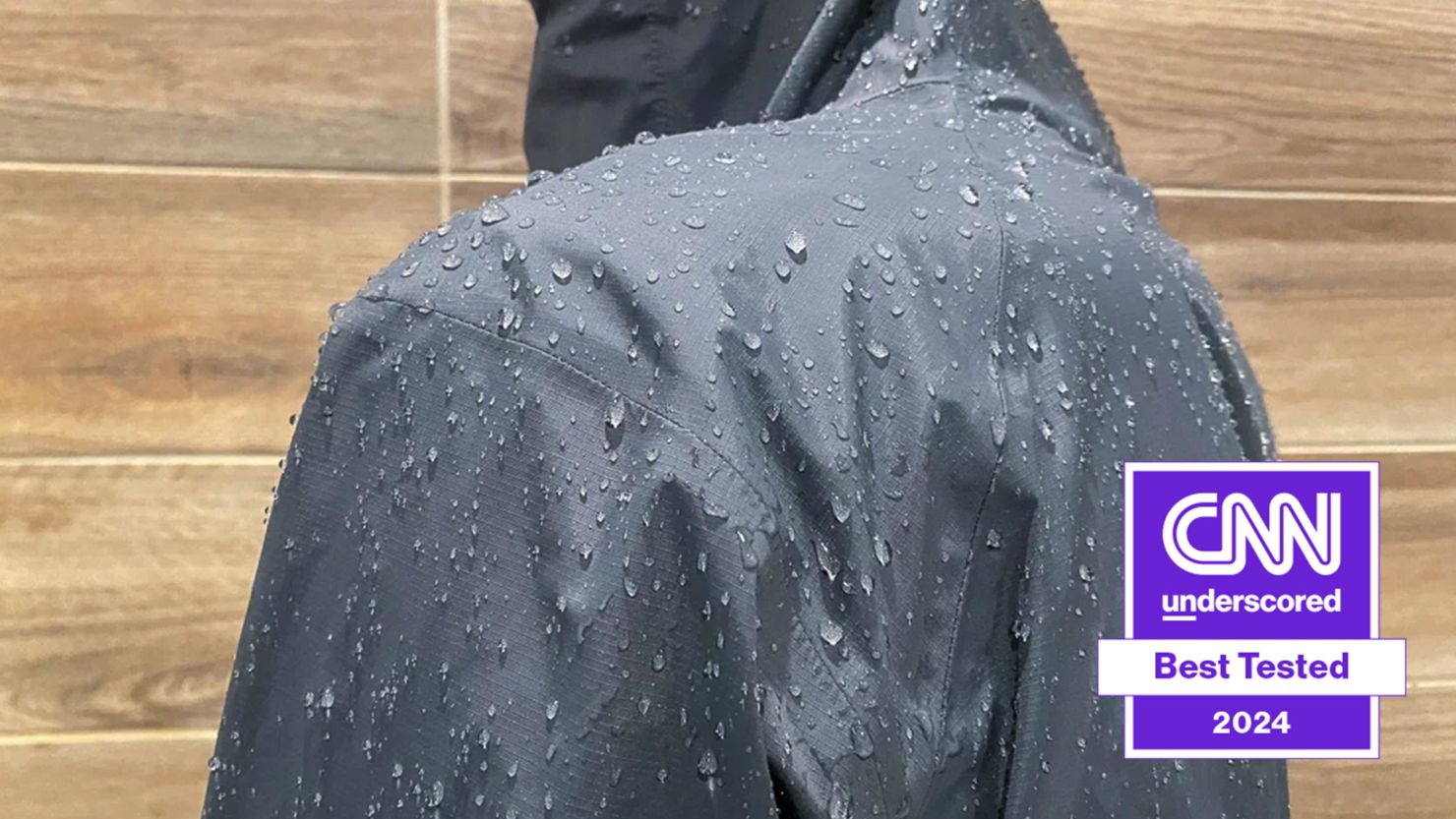Whether you’re camping, commuting or just running errands around town, the best rain jacket protects you from even the worst downpours and is an essential piece of waterproof hiking gear. We tested 22 top-rated jackets from popular brands like The North Face, Patagonia and Arc’teryx for their waterproofness, breathability, durability and more to find the best option out there. And after more than three months of testing, only one rain jacket stood out above the rest.
The Patagonia Torrentshell outperformed all the other jackets we tested in key areas. It's ridiculously waterproof and will keep you bone-dry in the worst rain, not to mention it's extremely breathable, durable and backed up by Patagonia's lifetime Ironclad Guarantee.
Our favorite jacket is available in men's and women's versions. The women's version is available in nine colors and sizes XS to XXL.
Whether you’re an avid hiker or just need protection from the rain during your commute, the Patagonia Torrentshell 3L is the one rain jacket you should buy.
Since we couldn’t rely on frequent heavy rainstorms to test the waterproofness of our jackets, we hopped in the shower for at least 5 minutes with each one to see if we would stay dry. It turns out showers, which on average dump 2.1 gallons per minute, are surprisingly good at simulating extreme rainfall.
During our indoor monsoon, the Torrentshell kept us completely dry, with only a tiny bit of water trickling in from the gap at the neck when we’d look up and from the cuffs when we’d raise our arms (which was typical of every jacket we tested, although some let tons of water in through the neck — more on that below). The Torrentshell’s three-layer shell meets the brand’s H2No Performance Standard and it kept us just as dry as jackets with Gore-Tex, probably the most well-known and trusted waterproof material in the outdoor industry.
The Torrentshell’s durable water-repellent (DWR) coating worked perfectly, causing any water that hit the shell to bead and run right off, preventing water from soaking into the jacket and pooling (which happened with a few other jackets we tested). Plus, since water runs right off, we could easily shake the Torrentshell dry after our test. This means you’ll never have to walk into work with a drenched jacket again. One thing to note is that the DWR on any jacket naturally deteriorates. Once you notice that water isn’t beading up anymore, it’s time to wash it and re-activate the water-repellent layer (more on how to do this and take care of your jacket below).
All the Torrentshell’s zippers are protected by a flap that didn’t allow a drop of water through, even when we pointed the shower’s stream directly onto them. So, unlike most of the jackets we tested — which didn’t have fully waterproofed zippers, allowing water to slowly (and sometimes not so slowly) leak through both the main zipper and the pockets — the Torrentshell protects your phone and other items from getting waterlogged.
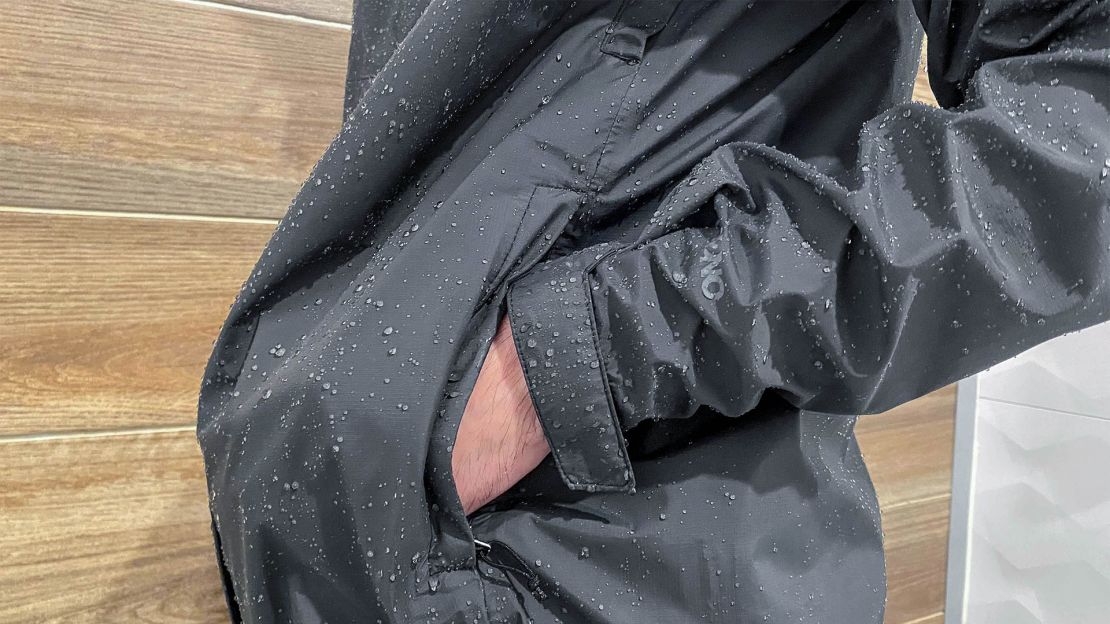
One aspect of the waterproofness test where the Patagonia fell short was its hood. While many other jackets had super-sturdy storm hoods, the Torrentshell’s wasn’t as large or stiff. The heavy stream from the shower caused the hood to bend slightly, so the water would sometimes run down our face. To compare, the Arc’teryx Beta LT had our favorite hood, which maintained its shape in the shower and kept the water far from our face. The only other wetness we experienced with the Torrentshell was water pooling up in the jacket’s hem, which happened with most other jackets we tested, too.
The Patagonia Torrentshell is super packable (though not as packable as the teeny tiny Outdoor Research Helium) and stuffs into its own pocket. It was also one of the more breathable jackets we tested. Whether you’re hiking through the backcountry or running late for work, you won’t feel as hot and muggy as with other jackets. Plus, its pit vents mean there’s an easy way to dump heat if you’re starting to build up a sweat.

While some of the other jackets we tested felt sticky, clammy or even itchy against our bare skin, the Torrentshell had one of the more comfortable interior materials, behind only The North Face’s Dryzzle, the Arc’teryx Beta LT and the Columbia OutDry Extreme Wyldwood Shell Jacket. It also proved quite durable by comparison. After rubbing it on concrete, it had a tiny, hard-to-notice hole. The only jackets that performed better in our second round of testing were the Arc’teryx Beta and the Jack Wolfskin Elsberg 2.5L.
Although the Torrentshell took some light damage, what’s great about this jacket (and all Patagonia apparel) is the brand’s Ironclad Guarantee. This warranty lets you send your clothes and gear in to get repaired (in most cases for free) at any time. Patagonia had the best warranty and repair policy of any jacket we looked at, which means if you’re willing to bring it into a store or mail it off to get fixed, the Torrentshell could last you decades.
Outdoor gear isn’t always the most eye-pleasing, which is why we love the Torrentshell’s variety of color options. As of publication, the men’s version is available in nine colors via Patagonia’s site and eight via REI, while the women’s comes in nine colors at both Patagonia and REI. Plus, it’s available in six sizes from XS to 3XL in men’s and XS to XXSL in women’s.
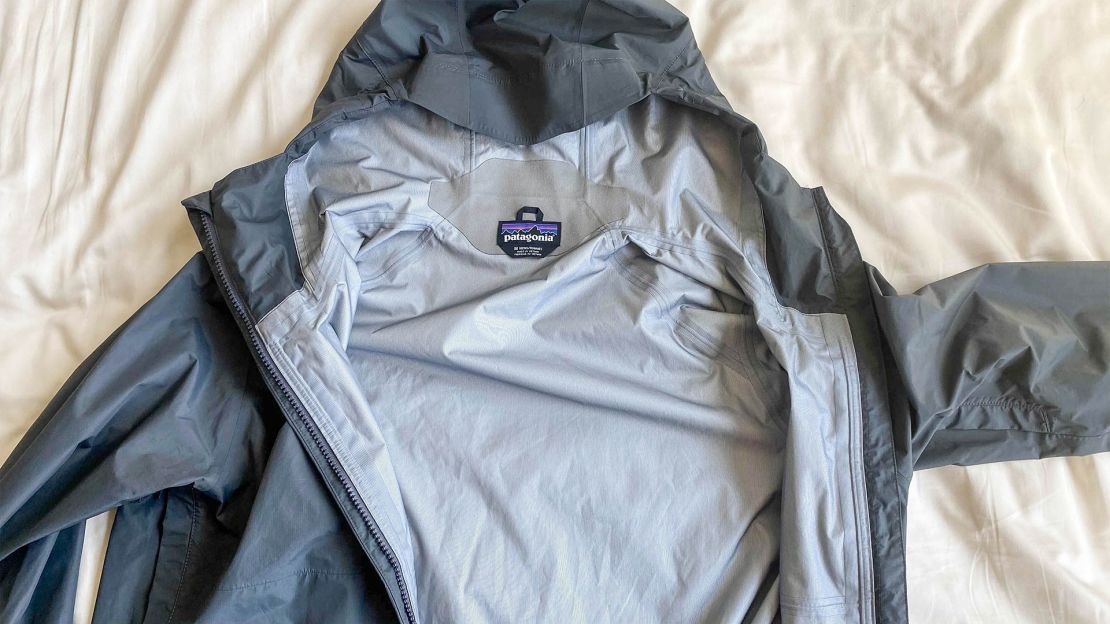
Everything you need to know about rain jackets
Rain jackets are a surprisingly complicated subject, so it’s good to know a little about what you’re getting into when buying one. The first thing to know is what these jackets are made out of. For years brands have innovated waterproof materials that can also be breathable, soft and comfortable. If all you want is protection from the rain, you can easily use a plastic poncho, but if you want to move around and not immediately start sweating, you’ll want to opt for a breathable rain jacket.
The most famous of these materials is Gore-Tex, which you’ve likely seen used in tons of brands and products, including coats, shoes and even gloves. But other brands, like Patagonia or The North Face, have created their own versions of waterproof fabrics that work in the same basic way. These fabrics are both waterproof and breathable because they have tiny pores too small to allow droplets of water through but big enough for the air and vapor from your body to escape.
This porous membrane is key to a coat’s waterproofness and is also part of the layering system you’ll see in the names and descriptions of rain jackets. There are two-layer, 2.5-layer and three-layer jackets which tell you about the build of the jacket.
A two-layer jacket essentially has only the outer material with a waterproof membrane on the inside. A 2.5-layer jacket has the same construction but with a sprayed or printed material on the inside to protect the membrane. Finally, a three-layer jacket has its outer material and a waterproof membrane as well as a whole other layer on the inside. There are differences in terms of the weight and feel between all three but for optimal waterproofness and durability, nothing beats a three-layer jacket. Its extra material completely protects the internal membrane so dirt and oils from your skin can’t clog the pores and make it less breathable.

The other key to waterproofness is a jacket’s durable water repellent or DWR. This is a coating applied to the outside of a rain jacket so water can bead up and run right off. DWR coatings stop working after a while which leads to the outer layer of a jacket soaking water. The internal membrane still keeps you dry but since that outer layer is filled with water, it will be harder for your sweat vapor to escape, making your jacket less breathable. You can re-activate your DWR coating by washing your jacket with a proper, technical detergent such as Nikwax.
You’ll often see ratings for waterproofness with the measurement of millimeters, which can be a little confusing. Waterproofness is denoted this way because it’s rated using the static-column test. This test consists of putting the material at the bottom of a 1-inch-diameter tube before filling it with water until the material leaks. The millimeter measurement is how tall this water column can get before the materials fail and water gets through; the higher the number, the more waterproof it is.
Other than waterproofness and breathability, you’ll want to look for different features depending on what you plan on doing. Lots of pockets help with a commute, a storm hood is great if you get caught in a storm on a hike, weight and packability are essential for backpackers and if you’re a climber or biker, you’ll want a helmet-compatible hood.
What are PFAS? Do I need a PFAS-free rain jacket?
If you’ve looked into buying a rain jacket, ski gear or even hiking boots in the past year, you’ve probably seen brands tout how their gear is newly “PFAS-free.” We have an entire explainer on the topic you can read, but you should know a few things about PFAS when shopping for jackets.
“PFAS stands for per- and polyfluoroalkyl substances,” said Dr. Joel Hartter, a professor of sustainability at the University of Colorado. “It’s a broad term encompassing a large group of human-made chemicals with specific properties. These chemicals share a carbon-fluorine bond structure that makes them very stable and resistant to degradation.” This resistance to degradation is where the chemicals get their nickname: “forever chemicals.”
Since the 1940s and ’50s, PFAS have been used in everything from Teflon frying pans to rain jackets. “Their widespread use stems from their ability to provide products with qualities that are highly valued in consumer goods and industrial applications — durability, stain resistance and water repellency, among others,” said Hartter. Unfortunately, these chemicals aren’t great for humans or the planet. But now governments are finally catching on, and according to Safer States, over 450 policies have been introduced in 35 states?to protect people from toxic chemicals.
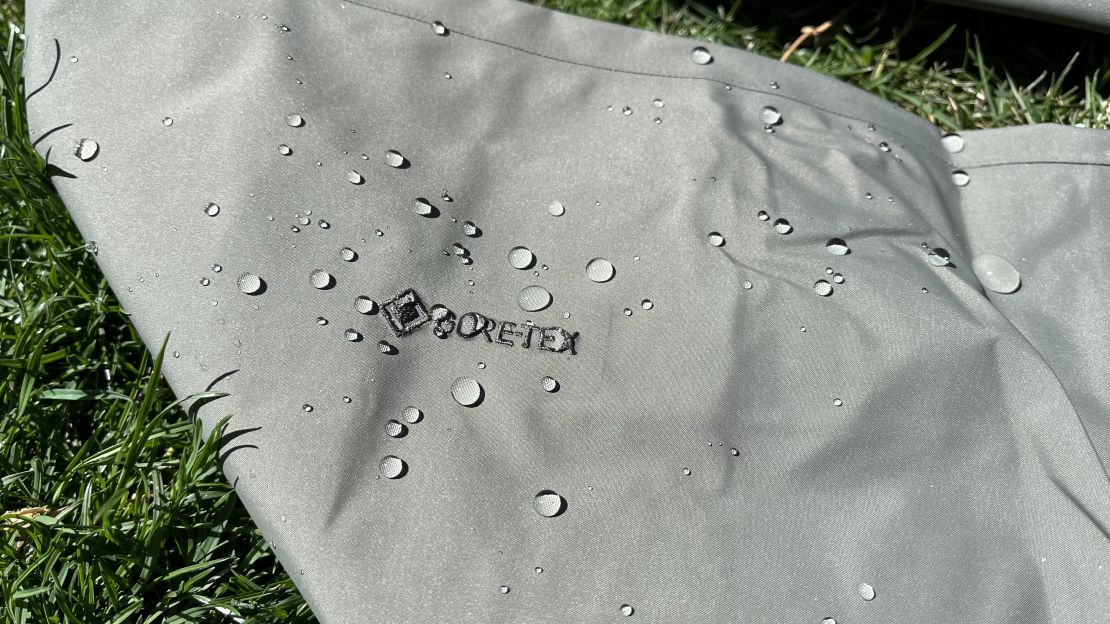
While certain states have banned PFAS in textiles, that doesn’t necessarily mean you should throw away your rain jacket and buy a new one. “Some exposures in some forms have been shown to have a link to birth defects and cancers, but it might [be] important to note that NONE have been shown from wearing a garment with PFAS intentionally added (durable water repellency, for example) — but the creation of those materials and the workers exposed to it during production would certainly see elevated risks to their health,” says Alex Lauver, Outdoor Research’s sustainability lead and co-chair of the Outdoor Industry Association’s Clean Chemistry and Materials Coalition.
However, Hartter says you might want to consider how long and how often you wear a PFAS-laden jacket to make your decision. “Occasional use likely poses a lower risk than frequent or long-term wear. Direct contact between the jacket and your skin, especially for extended periods, increases potential exposure. Certain health conditions or compromised immune systems might make individuals more susceptible to PFAS effects.”
Both Hartter and Lauver encourage consumers to think long and hard before they toss out their old jackets and buy a new, PFAS-free one. “If you own/wear/love a current jacket with intentionally added PFAS, the best thing might be to ensure it has a long life and dispose of it correctly when it’s worn out,” said Lauver. Hartter echoes this too and says, “While the presence of PFAS in older products is not ideal, the decision to replace a jacket should be weighed against the environmental cost of disposal. Simply throwing it away might contribute to landfill waste and doesn’t prevent the PFAS from eventually entering the environment. Look into recycling programs or ways to repurpose the jacket for continued use.”
How to take care of a rain jacket
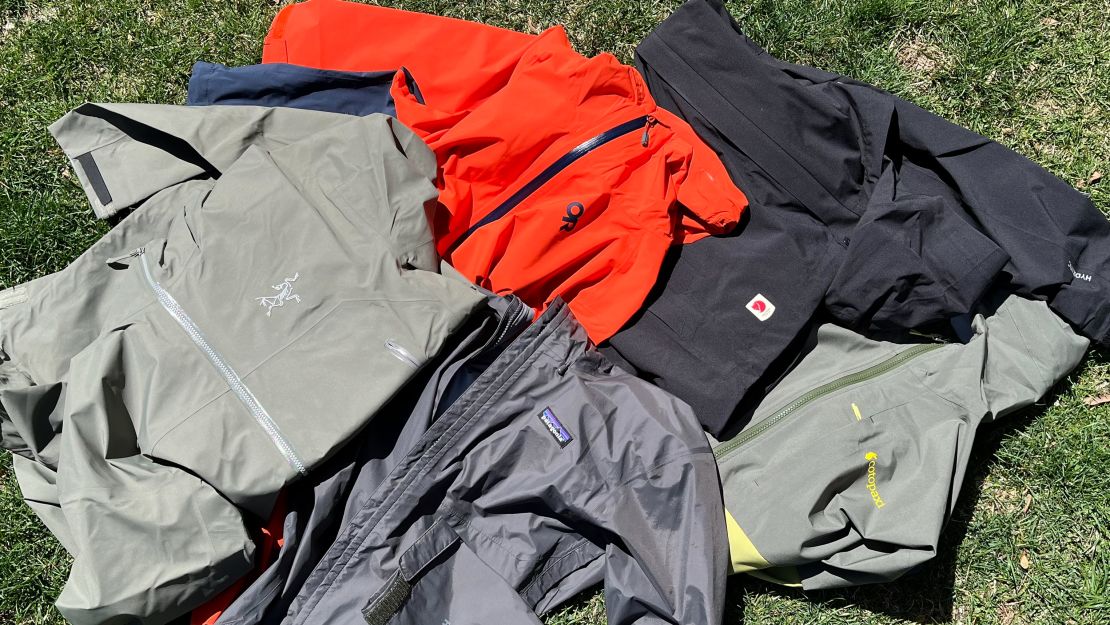
Since PFAS have been phased out of the rain jacket market (all the jackets we tested in our latest round of testing were PFAS-free), you may wonder if these new jackets will be as waterproof as before. “Companies are replacing PFAS in rain jackets with PFC-free durable water-repellent (DWR) treatments, new polymer technologies that are more environmentally friendly, natural wax-based coatings and tightly woven fabrics that mechanically repel water. Other companies are ahead of the curve and are already designing PFAS-free, high-performance rain jackets,” says Hartter.
Some elements of these alternatives, however, might not be as durable as PFAS. “PFAS is very good at what it does, so as we shift away from fluorinated chemistries, there will be performance sacrifices,” says Lauver.?“First and foremost, many do not have the oleophobicity (oil repellency) of fluorinated versions.?That means your DWR (water beading on the outside) will not be as durable. Generally, you can wash and re-treat (with Nikwax for example) to improve, but you will need to do it much more often.” Lauver recommends washing your rain jacket to ensure it maintains its performance about twice per season, depending on how often you use it.
How we tested
To find the best rain jacket, we tested everything from waterproofness and breathability to fit, feel and packability. We broke up our tests into three categories — performance, durability and versatility — so we could compare the different features of each jacket against the others directly. Here’s a full breakdown of all the tests we ran.
Performance
- Waterproofness: We wore each jacket in the shower for at least 5 minutes, with all zippers closed and the hood up. We spun around and focused the shower stream on different parts of the jackets, such as the zippers, shoulders and hood. We then took off the jacket and took note of how wet our shirt underneath got and where. We also put tissues in all the pockets of the jacket and saw if they got wet at all during the shower.
- Breathability: We wore each jacket and rode a Peloton bike for 10 minutes, keeping a consistent, light output. We judged how hot or sweaty we got and how soon into our ride we felt muggy.
- Fit, feel and stretch: We tried on each jacket multiple times and stretched to see if there were any restrictive areas. We wore the jacket and judged its length as well as how roomy it was in both the torso and arms. We also wore each jacket on our bare arms and judged how comfortable each felt against our skin.
- Weight: We weighed each jacket on a kitchen scale.
Durability
- Rub test: We rubbed the shoulder and arm of each jacket against a rough surface (in our latest round it was a concrete sidewalk) five times. We noted any scuffs, scratches or wear and tear to the material.
- Zip test: We zipped the main zipper up and down 50 times and took note of how many times it snagged or if it broke. We also paid attention to any deterioration throughout our testing process.
- Washability: We followed the wash instructions for each jacket and judged if it shrank or deteriorated in any way.
- Warranty: We researched the warranty for each jacket.
Versatility
- Pockets and extra attributes: We counted any extra features, such as pit vents, helmet compatibility, pockets and more.
- Packability: We packed each jacket (into its own pocket if possible) and compared which ones got the smallest.
- Sizing and colors: We counted how many sizes and colors were available for each jacket in both men’s and women’s versions.
Other rain jackets we tested
Arc’teryx Beta LT
$450 at REI Co-op
This jacket was fantastic, but it fell short in a few tests. The fact it didn’t blow the other jackets out of the water, paired with the highest price tag in our testing pool, makes this jacket a tough purchase to justify. As we said earlier, it had our favorite hood, plus its waterproofness and breathability performance were stellar. Its zippers, however, are only water-resistant, not waterproof, and both our shirt and the tissues in our pockets got a bit wet. You can save money and get a slightly better jacket with the Patagonia Torrentshell.
Outdoor Research Helium Rain Jacket
$170 at Outdoor Research
This jacket was another one of our favorites, and while it didn’t score extremely high, it was solidly waterproof and breathable. The interior is a bit sticky and feels clammy against our skin, but if you’re an avid hiker or backpacker, the Helium’s extreme packability just might be enough to sell you. It was the lightest jacket we tested, weighing only 6.26 ounces. For reference, the next lightest was about 7.5 ounces and the next after that was nearly 10 ounces. Additionally, the Helium stuffs down into its sole chest pocket into a tiny package that’s about the size of our hand. So, if you’re searching for the lightest jacket you can throw in your backpack for a thru-hike and don’t care as much about comfort or durability, the Helium is a great choice.
Patagonia Boulder Fork
$229 at Patagonia
This Patagonia rain jacket is slightly lighter than the Torrentshell, has a comfortable interior and was completely waterproof except for the pockets in our tests. It wasn’t as durable in our rub tests, and although it’s backed by Patagonia’s Ironclad Guarantee, the Torrentshell is the better pick, especially considering the price.
Jack Wolfskin Elsberg 2.5L
$180 From $162 at Jack Wolfskin
Jack Wolfskin has been PFAS-free since 2019, but the Elsberg couldn’t quite compete with the Torrentshell. It’s lightweight, flexible and a great packable jacket, but it only has a 2.5-layer membrane versus the Torrentshell’s three-layer one. Similar to all the other 2.5-layer jackets we tried in our most recent round of testing, it had a couple of wet spots come through in the shower and the interior lining was damp.
Outdoor Research Stratoburst Stretch Rain Jacket
$165 at Outdoor Research
This was one of the stretchiest jackets we tested and it’s very light at just 8.5 ounces. However, after our shower test, we had a few wet spots and we felt hotter after our breathability tests than in our winner. For just $15 more, we think the Torrentshell is a better value.
Fjallraven High Coast Hydratic Trail Jacket
$275 at Fjallraven
This stylish jacket has a loose fit and lots of stretch, but it also had wet pockets, a wet hem and interior dampness after our shower test. It was also one of the least breathable jackets we tested, and for $275, we think you’d be better off with the Torrentshell.
Arc’teryx Beta
$400 at Arc’teryx
The newly revised Beta is weirdly lighter (and $50 cheaper) than the Beta LT, and performed nearly as well as the Patagonia Torrentshell in our waterproof tests, only suffering some slightly wet pockets after 5 minutes in the shower. The Beta’s durability really stood out in our second round of testing, as it was only one of two jackets to rub against concrete and come out unscathed (the other was the Jack Wolfskin Elsberg). However, for $400, we think it’s too pricey when the Torrentshell is just as good.
Cotopaxi Cielo Rain Jacket
$145 at Cotopaxi
Cotopaxi has a warranty and repair policy that rivals Patagonia’s Ironclad Guarantee, but we got some wet spots when wearing the Cielo in the shower. That, coupled with its clammy interior feel, took it out of the running for our top spot.
Columbia Men’s OutDry Extreme Wyldwood Shell Jacket
$200 at Columbia
Columbia’s OutDry technology puts the brand’s waterproof membrane on the outside of the jacket instead of the inside. This means you don’t get that gross, clammy and cold feeling with this jacket, but also that the membrane is more susceptible to damage. In our testing, it was just as waterproof as our winner, with just one wet tissue, but it felt hotter after our bike ride. The pockets are strangely designed and hard to get into, and the aesthetic of the jacket isn’t for everyone either.
REI Co-op Trailmade Rain Jacket
$70 at REI
The REI Co-op jacket was surprisingly waterproof and outperformed jackets that cost $100 more. However, it was quite hot during our breathability test and it has a lot of material, making it feel bulky and awkward. While this jacket didn’t beat the others, it’s decent for its price.
Frogg Toggs Xtreme Lite Jacket
From $39 at Amazon
Lightweight, surprisingly comfortable, and waterproof enough for mellow strolls and short hikes near town, Frogg Toggs’ Xtreme Lite Rain Jacket was one of the cheapest on our testing roster but also one of the least durable. Though the garment’s arms and hood were adequately taped to survive ten minutes of a torrential showerhead downpour, the entire length of the front zipper soaked through, due to being made with ordinary fabric. As such, we can’t recommend it for big-mile days or heavy backcountry use, but it would?make a half-decent emergency poncho.
The North Face Dryzzle Futurelight Jacket
$230 at The North Face
The North Face’s Dryzzle jacket features the brand’s waterproof technology, Futurelight. This membrane is just like Gore-Tex, promising extreme waterproofing while maintaining breathability. We were quite impressed with the Dryzzle, especially the feel of the jacket both inside and out. However, it didn’t quite separate itself from other great jackets we tested. Our biggest gripe was the quality of the DWR coating on the jacket. When water hit this jacket it didn’t immediately bead up and shed like many others we tested. In some places, we could see visible spots where the water was soaking into the outer layer. It was one of our highest-scoring jackets, but with a lackluster DWR coating and a higher price tag than our winner, we can’t recommend it.
REI Co-op Rainier Rain Jacket
Unavailable at REI
This jacket was one of the cheapest we tested but surprised us with its solid scores throughout our testing process. It was solidly waterproof, decently breathable and an overall fantastic jacket. It didn’t score as high as the Torrentshell, mostly due to its sticky interior. We plan to try the new version of the Rainier in our next round of testing.
Arc’teryx Zeta SL
Unavailable at Arc’teryx
The Zeta SL from Arc’teryx was another high-scoring jacket, coming in right around the top. It’s super waterproof and breathable, and its interior feels relatively comfortable. However, like the other Arc’teryx jacket we tested, its zippers aren’t fully waterproof, only water-resistant. It also doesn’t have as many extra features as the Torrentshell, which was disappointing for a $300 jacket.
REI Co-op Drypoint GTX
Unavailable at REI
This jacket from REI Co-op was another high scorer but just didn’t do well enough to edge out the competition. It’s also a discontinued item, so it’s only available in one color and stock will eventually run out. Even at a massively discounted price, it’s more expensive than our winner, so while it’s a solid jacket, there are better options.
Black Diamond Stormline
$180 From $135 at Black Diamond
The Stormline was the stretchiest jacket we tested in our first round and had quite a high score. It’s nice and light and felt nice both on the outside and inside. It was mostly waterproof, with just a tiny bit of water getting into the pockets. If you need an extremely stretchy and malleable jacket, the Stormline would be a great pick, but overall it couldn’t beat out the other coats we tested.
Marmot Minimalist
$220 at Marmot
This jacket was one of the more breathable jackets we tested, but its pockets — like many others — weren’t waterproof. A bit of water got into the two side pockets, and the tissue inside the chest pocket got completely soaked. It didn’t stand out for any reason, but it’s still a solid rain jacket. Just don’t put your phone in its pockets.
Outdoor Research Microgravity
$279 at Outdoor Research
The Microgravity from Outdoor Research fell out of contention after a poor waterproofness test. Again, the pockets were its downfall, and in the Microgravity’s case, so much water came through all of its pockets that our shirt got wet underneath. The interior material also felt quite itchy, so we just can’t justify spending full price on this jacket.
L.L.Bean H2Off
$179 at L.L.Bean
The L.L.Bean was the heaviest jacket we tested, but it does have tons of pockets to carry everything you need when you go out. However, those pockets are nowhere close to being waterproof. Every tissue we put in its pockets came out drenched.
Columbia OutDry Ex Nanolite Shell
Currently unavailable at Columbia
This jacket did not score well, due mainly to a poor waterproofness test. Its hood channeled water down our face and right into the jacket itself. We had to look directly at the ground to keep the water out and couldn’t move our head like we could with other jackets. At the end of our test, our shirt was completely soaked. It is incredibly light, but if you’re looking for a packable jacket, go for the $170 Outdoor Research Helium instead.
Columbia OutDry Ex Reign
Currently unavailable at Columbia
This jacket had the same hood issue as the other Columbia coat, and water ran right down into the neck of the jacket. It’s heavy, not portable, doesn’t feel comfortable on the inside and isn’t very breathable either.
Helly-Hansen Moss Hooded Raincoat
From $32 at Amazon
This jacket didn’t impress us much, as it wasn’t very breathable, didn’t hold up well in our rub test and is the only jacket we tested that you can’t throw in the dryer. It was decently waterproof, but its hood is a little flimsy and its pockets don’t zip close, although the tissues we put in there didn’t get as wet as some other jackets.
